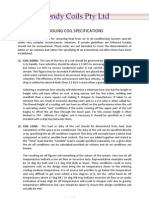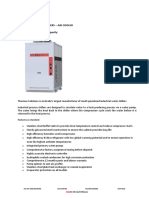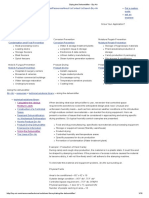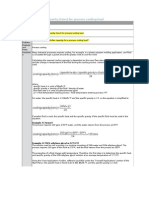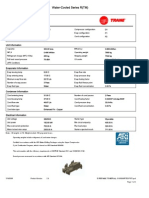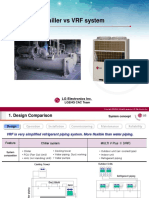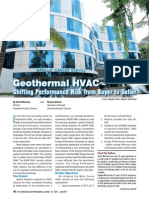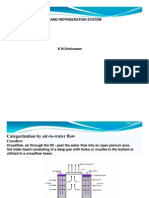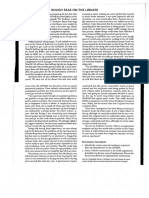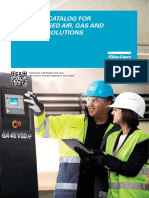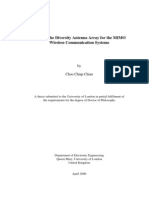Cooling Tower Efficiency Calculations
Cooling Tower Efficiency Calculations
Uploaded by
Pramod Sharma0 ratings0% found this document useful (0 votes)
45 views3 pagesThe document discusses cooling tower efficiency calculations. It defines key terms like cooling tower approach, range, and efficiency. The efficiency is calculated as the range divided by the sum of the range and approach, and represents how close the cold water temperature gets to the wet bulb temperature. Higher efficiencies between 70-75% are possible, but require larger towers. The document also covers other calculations like cycle of concentration, blowdown, evaporation loss, and makeup water requirements.
Original Description:
I m upload my documents
Original Title
Document
Copyright
© © All Rights Reserved
Available Formats
DOCX, PDF, TXT or read online from Scribd
Share this document
Did you find this document useful?
Is this content inappropriate?
Report this DocumentThe document discusses cooling tower efficiency calculations. It defines key terms like cooling tower approach, range, and efficiency. The efficiency is calculated as the range divided by the sum of the range and approach, and represents how close the cold water temperature gets to the wet bulb temperature. Higher efficiencies between 70-75% are possible, but require larger towers. The document also covers other calculations like cycle of concentration, blowdown, evaporation loss, and makeup water requirements.
Copyright:
© All Rights Reserved
Available Formats
Download as DOCX, PDF, TXT or read online from Scribd
Download as docx, pdf, or txt
0 ratings0% found this document useful (0 votes)
45 views3 pagesCooling Tower Efficiency Calculations
Cooling Tower Efficiency Calculations
Uploaded by
Pramod SharmaThe document discusses cooling tower efficiency calculations. It defines key terms like cooling tower approach, range, and efficiency. The efficiency is calculated as the range divided by the sum of the range and approach, and represents how close the cold water temperature gets to the wet bulb temperature. Higher efficiencies between 70-75% are possible, but require larger towers. The document also covers other calculations like cycle of concentration, blowdown, evaporation loss, and makeup water requirements.
Copyright:
© All Rights Reserved
Available Formats
Download as DOCX, PDF, TXT or read online from Scribd
Download as docx, pdf, or txt
You are on page 1of 3
Cooling Tower
Cooling Tower Efficiency
Calculations
Last updated April 8, 2018
Cooling Tower Efficiency Calculation is described in this article. Cooling Towerplays a
major role in Chemical Process Industry. They reject process heat from the cooling
water to atmosphere and keep the water cool. The performance of the cooling tower
depends on various parameters like Range & Approach. We shall see those
terminologies in Detail.
Cooling Tower Approach
The difference between the Cold Water Temperature (Cooling Tower Outlet)
And ambient Wet Bulb Temperature is called as Cooling Tower Approach.
Approach = Cold Water Temperature – Wet Bulb Temperature
Cooling Tower approach is the better indicator of the performance.
Cooling Tower Range
The difference between the Hot Water Temperature (Cooling Tower Inlet) Temperature
and Cold water (Cooling Tower Outlet) temperature is called Cooling Tower Range.
Range = Hot Water Temperature – Cold Water Temperature
Cooling Tower Efficiency Calculation
The calculation of cooling tower efficiency involves the Range and approach of the
cooling Tower. Cooling tower efficiency is limited by the ambient wet bulb temperature.
In the ideal case, the cold water temperature will be equal to the wet-bulb temperature.
This is practically not possible to achieve. This requires very large tower and results in
huge evaporation and windage or drift loss resulting in a practically not viable solution.
In practice, the cooling tower efficiency will be in between 70 to 75%.
Cooling Tower Efficiency =
(Hot Water Temperature – Cold water Temperature) x 100/
(Hot Water Temperature – Wet bulb temperature)
Or Simply
Cooling Tower Efficiency = Range/ (Range + Approach) x 100
In summer the ambient air wet bulb temperature raises when compared to winter thus
limiting the cooling tower efficiency.
Other Cooling Tower Calculations
This includes determination of cycle of concentration, Evaporation loss, Drift or Windage
Loss, Blow down water requirement makeup water requirement.
Cycle of Concentration
The cycle of concentration is a dimensionless number. It is a ratio between parameter in
Cooling Water to the parameter in Makeup water. It can be calculated from any the
following formulae.
COC= Silica in Cooling Water / Silica in Makeup Water
COC = Ca Hardness in Cooling Water/ Ca Hardness in Makeup water
COC = Conductivity of Cooling Water / Conductivity of Makeup water
The cycle of concentration normally varies from 3.0 to 7.0 depending on the Process
Design. It is advisable to keep the Cycle of concentration as high as possible to reduce
the makeup water requirement of the cooling tower. At the same time, the higher cycle
of concentration increases the dissolved solids concentration in circulating cooling water
which results in scaling and fouling of process heat transfer equipment.
Draw off or Blowdown
As the cooling water circulates the cooling tower part of water evaporates thereby
increasing the total dissolved solids in the remaining water. To control the Cycle of
Concentration blow down is given. Blowdown is the function of Cycle of concentration.
Blowdown can be calculated from the formula:
B = E/ (COC-1)
B = Blow Down (m3/hr)
E = Evaporation Loss (m3/hr)
COC = Cycle of Concentration. Varies from 3.0 to 7.0 depending upon Manufactures
Guidelines
Evaporation Loss Calculation
Evaporation Loss in the cooling tower is calculated by the following empirical equation.
E = 0.00085 x R x 1.8 x C
E = Evaporation Loss (m3/hr)
R= Range
C = Circulating Cooling Water (m3/hr)
You might also like
- BECSys 2 Tech ManualDocument29 pagesBECSys 2 Tech Manualcory1353100% (1)
- SRL Diagnostics: Types of Cooling Tower - Cooling Tower Basic CalculationsDocument13 pagesSRL Diagnostics: Types of Cooling Tower - Cooling Tower Basic CalculationssumitNo ratings yet
- Basics of Refrigeration - EvaporatorsDocument32 pagesBasics of Refrigeration - Evaporatorsfarazgazanfar-1No ratings yet
- Combining DOAS and VRF, Part 2 of 2Document9 pagesCombining DOAS and VRF, Part 2 of 2miniongskyNo ratings yet
- Sumair Project Report PPT HVACDocument37 pagesSumair Project Report PPT HVACRishabh SinghNo ratings yet
- Ahu & Chiller OkDocument40 pagesAhu & Chiller OkAndy DwiNo ratings yet
- Bry Air QuestionarysectionDocument7 pagesBry Air Questionarysectionprashant_mahitkar4532No ratings yet
- HVAC Comparison (ZA)Document29 pagesHVAC Comparison (ZA)Sameer Aslam SNo ratings yet
- Chillers: The Machine Which Produce The Chilled Water To Distribute It To Different SpacesDocument11 pagesChillers: The Machine Which Produce The Chilled Water To Distribute It To Different SpacesMostafa Elmaghraby 467No ratings yet
- Cooling Tower: Refrigeration and Air Conditioning LabDocument40 pagesCooling Tower: Refrigeration and Air Conditioning LabEngr Saad Bin SarfrazNo ratings yet
- Primary VFD and Chiller SystemDocument52 pagesPrimary VFD and Chiller SystemEko Supramono PurbaNo ratings yet
- Ishrae: Submitted To Mrs. Bhavana Mathur Mr. Sunil SharmaDocument35 pagesIshrae: Submitted To Mrs. Bhavana Mathur Mr. Sunil SharmaAnurag JoshiNo ratings yet
- COIL Selection Formulas PDFDocument3 pagesCOIL Selection Formulas PDFWalter100% (1)
- Chilled Water System Sequence of OperationDocument3 pagesChilled Water System Sequence of OperationdimasNo ratings yet
- Air Handling Units CatalogueDocument23 pagesAir Handling Units CatalogueAlsayed Rabiea MiesalamNo ratings yet
- Chiller Selection SoftwareDocument2 pagesChiller Selection SoftwarePrashantNo ratings yet
- Tear Cooling Tower Energy Operating Cost SoftwareDocument9 pagesTear Cooling Tower Energy Operating Cost Softwareforevertay2000No ratings yet
- Benefits and Design Tipsfor ChillersDocument4 pagesBenefits and Design Tipsfor ChillersSharon LambertNo ratings yet
- PCU0610A - Chiller (Small)Document16 pagesPCU0610A - Chiller (Small)jeromeduytscheNo ratings yet
- Cooling Coil Design (SI Units)Document3 pagesCooling Coil Design (SI Units)Christopher PersaudNo ratings yet
- Chiller PDFDocument20 pagesChiller PDFredaNo ratings yet
- 2018 Multi V 5Document72 pages2018 Multi V 5Vo DungNo ratings yet
- Cooling Tower - BaltimoreDocument7 pagesCooling Tower - BaltimoreОсама А.ШоукиNo ratings yet
- Coil Selection FormatDocument3 pagesCoil Selection FormatFarzanaShaikNo ratings yet
- CertifiedDocument11 pagesCertifiedJeyaraj NellaiarasanNo ratings yet
- Reference BooksDocument536 pagesReference BooksAung San HtweNo ratings yet
- Air Handling Unit QualificationDocument20 pagesAir Handling Unit Qualificationsainzb83No ratings yet
- Hvac Formulas PDFDocument3 pagesHvac Formulas PDFdasmechNo ratings yet
- SKM FCU High Static DetailDocument28 pagesSKM FCU High Static DetailInzamamNo ratings yet
- Technical Data Sheet Industrial Water Chillers - Air Cooled 12kW To 25kW Cooling CapacityDocument9 pagesTechnical Data Sheet Industrial Water Chillers - Air Cooled 12kW To 25kW Cooling CapacityPARTHIBAN RETECHNo ratings yet
- AHU Coil TypesDocument100 pagesAHU Coil Typeskothat82No ratings yet
- تقرير تدريب صيفي لواء الدين مظفرDocument23 pagesتقرير تدريب صيفي لواء الدين مظفرlalaNo ratings yet
- Article 3 Brine Circulated SystemsDocument46 pagesArticle 3 Brine Circulated Systemsmdalt9180No ratings yet
- Chap 10 HvacDocument30 pagesChap 10 HvacVikrant HaribhaktaNo ratings yet
- Chilled Water PipingDocument6 pagesChilled Water Pipingunicornmep100% (1)
- Sizing The Dehumidifier - Bry Air PDFDocument16 pagesSizing The Dehumidifier - Bry Air PDFprabhanshu241991100% (1)
- Chilled Water Piping Distribution Systems Ashrae 3-12-14Document78 pagesChilled Water Piping Distribution Systems Ashrae 3-12-14haseebamerNo ratings yet
- Calculate Chiller CapacityDocument2 pagesCalculate Chiller Capacityhima007100% (6)
- Water-Cooled Series R (TM) RTHD Product ReportDocument2 pagesWater-Cooled Series R (TM) RTHD Product ReporttrangocvuNo ratings yet
- CT PresentationDocument22 pagesCT PresentationJithin DasNo ratings yet
- Selection of Water Cooled Chiller - 221 TR PDFDocument2 pagesSelection of Water Cooled Chiller - 221 TR PDFcalvin.bloodaxe4478No ratings yet
- Selection Sheet - 30XA452 Screw ChillerDocument1 pageSelection Sheet - 30XA452 Screw Chillercalvin.bloodaxe4478No ratings yet
- Chiller ConfigurationDocument8 pagesChiller Configurationavid_ankurNo ratings yet
- Heat Wheel: Mohammad Yusuf 13PKB380Document10 pagesHeat Wheel: Mohammad Yusuf 13PKB380Haider Ali100% (1)
- Cooltech Prsentation - May 2016Document12 pagesCooltech Prsentation - May 2016Cooltech ApplicationsNo ratings yet
- Water Cooled ChillerDocument5 pagesWater Cooled ChillerMUHAMMAD TAHANo ratings yet
- Hvac Design and DraftingDocument3 pagesHvac Design and DraftingAdil ShahNo ratings yet
- Chiller Vs VRF PDFDocument26 pagesChiller Vs VRF PDFHenry San PedroNo ratings yet
- FCU McQUAYDocument12 pagesFCU McQUAYben_splNo ratings yet
- 02 Cooling Load Calculation - HAPDocument2 pages02 Cooling Load Calculation - HAPU DEEPAKNo ratings yet
- HVAC TrainingDocument55 pagesHVAC TrainingKkrkollam KrishnaKumarNo ratings yet
- Psychrometry and Air ConditioningDocument35 pagesPsychrometry and Air ConditioningPavithran100% (1)
- Geothermal HVAC: Shifting Performance Risk From Buyer To SellerDocument5 pagesGeothermal HVAC: Shifting Performance Risk From Buyer To SellerKagitha TirumalaNo ratings yet
- Structure Maintainer, Group H (Air Conditioning & Heating): Passbooks Study GuideFrom EverandStructure Maintainer, Group H (Air Conditioning & Heating): Passbooks Study GuideRating: 5 out of 5 stars5/5 (1)
- Cooling Tower Efficiency CalculationsDocument4 pagesCooling Tower Efficiency CalculationsMaman HakimNo ratings yet
- Cooling Tower Efficiency CalculationsDocument5 pagesCooling Tower Efficiency Calculationsidigiti100% (1)
- Cooling Tower Efficiency CalculationDocument4 pagesCooling Tower Efficiency CalculationVijay PotdukheNo ratings yet
- Cooling TowerDocument11 pagesCooling TowerAshok PatelNo ratings yet
- Easy Guide To Cooling Tower Efficiency & How To Increase ItDocument10 pagesEasy Guide To Cooling Tower Efficiency & How To Increase ItAlain DuribreuxNo ratings yet
- Cooling Tower Efficiency Calculations PDFDocument4 pagesCooling Tower Efficiency Calculations PDFhbithoNo ratings yet
- Cooling Tower PDFDocument30 pagesCooling Tower PDFcynaidu100% (1)
- Case - Rita's Issue at Work McshaneDocument8 pagesCase - Rita's Issue at Work McshanePETRUS DAVIDNo ratings yet
- The Effects of Facebook Addiction On The Academic Performance of Grade 12 Humss Students in Marikina High School S.Y. 2020-2021Document7 pagesThe Effects of Facebook Addiction On The Academic Performance of Grade 12 Humss Students in Marikina High School S.Y. 2020-2021Nathalie Uba100% (2)
- Polysafe Astral PUR Product SpecDocument1 pagePolysafe Astral PUR Product SpecFloorkitNo ratings yet
- JMC 92x38 DC FanDocument3 pagesJMC 92x38 DC FanJMCproductsNo ratings yet
- M 15Document2 pagesM 15Александр ОстапенкоNo ratings yet
- 200 Sets in One Made by ToddyDocument60 pages200 Sets in One Made by ToddymissescatherinekooperNo ratings yet
- General Catalog For Compressed Air, Gas and Vacuum SolutionsDocument220 pagesGeneral Catalog For Compressed Air, Gas and Vacuum Solutionsgomera100% (1)
- Planning Filing For Blake Avenue Development Los AngelesDocument141 pagesPlanning Filing For Blake Avenue Development Los AngelesTheEastsiderNo ratings yet
- Exam AddDocument3 pagesExam AddZen OrganisNo ratings yet
- Matrix EP and TK TDS 2035Document1 pageMatrix EP and TK TDS 2035Don HowardNo ratings yet
- SAP Consignment Stock-US HenkelDocument12 pagesSAP Consignment Stock-US HenkelkomalNo ratings yet
- Buzz SessionDocument17 pagesBuzz SessionEvelyn Avila Bellen100% (1)
- Sla 12vdc SL A SongleDocument2 pagesSla 12vdc SL A SongleAHMAD NUR IMAMNo ratings yet
- MIMO Wireless CommunicationDocument170 pagesMIMO Wireless CommunicationAli Ahmad100% (2)
- Project Management On New Product Development and New Product Launch in The Automotive Industry Project Management Represents The Combination Between KnowDocument7 pagesProject Management On New Product Development and New Product Launch in The Automotive Industry Project Management Represents The Combination Between KnowapoorvaNo ratings yet
- Turbofan Engine Working Principle, Performance and ApplicationDocument12 pagesTurbofan Engine Working Principle, Performance and ApplicationMé LıssąNo ratings yet
- Chapter 11 Deep FoundationsDocument47 pagesChapter 11 Deep FoundationsYoseph Birru100% (1)
- Merkel Double Wiper PRW 1 With Integrated Pressure ReliefDocument3 pagesMerkel Double Wiper PRW 1 With Integrated Pressure Reliefpepe01250No ratings yet
- Ba Bfk458 enDocument52 pagesBa Bfk458 enWalterLlenqueTrellesNo ratings yet
- Fluid Mechanics Question and SolutionsDocument4 pagesFluid Mechanics Question and Solutionsrahvin harveyNo ratings yet
- Experiment 4 - Frequency Modulation Using ScilabDocument6 pagesExperiment 4 - Frequency Modulation Using ScilabCleiton Marques0% (1)
- Farm Level: Low Cost Dryer (SRR and STR Dryers)Document2 pagesFarm Level: Low Cost Dryer (SRR and STR Dryers)Dessa MatroNo ratings yet
- DPR 6162Document5 pagesDPR 6162Douvinda TVNo ratings yet
- Alform 700 MCDocument9 pagesAlform 700 MCCarlos Nombela PalaciosNo ratings yet
- Ericsson Axe PlatformDocument27 pagesEricsson Axe Platformtongai_mutengwa5194100% (1)
- Air Conditioner: Aesthetics and ErgonomicsDocument13 pagesAir Conditioner: Aesthetics and ErgonomicsRadhey PatankarNo ratings yet
- UCT APM M1 U3 - Activity SubmissionDocument4 pagesUCT APM M1 U3 - Activity SubmissionMichael Ampah Yeboah100% (1)
- Solution To The Positive Real Control Problem For Linear Time-Invariant SystemsDocument13 pagesSolution To The Positive Real Control Problem For Linear Time-Invariant SystemsRohit GandhiNo ratings yet
- Overhaul of Centrifugal Gas CompressorDocument61 pagesOverhaul of Centrifugal Gas CompressorAvinash KulkarniNo ratings yet



















